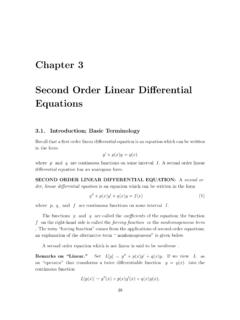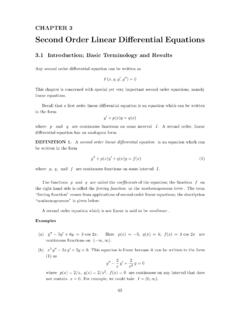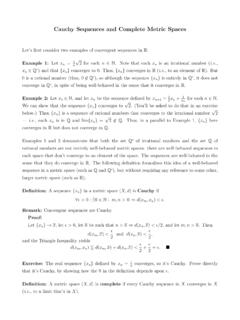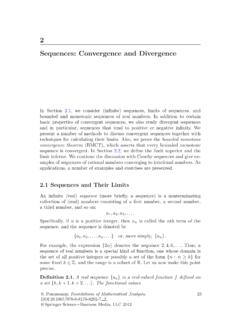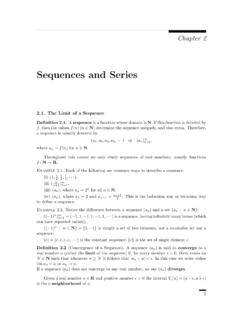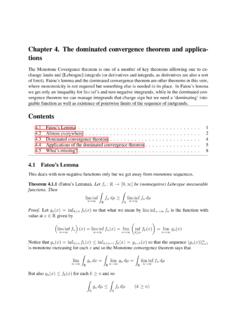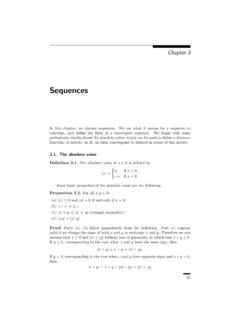Transcription of PART II. SEQUENCES OF REAL NUMBERS
1 PART II. SEQUENCES OF REAL CONVERGENCED efinition a real-valued functionfwhose domain is the set positive integers(N). The numbersf(1),f(2), are called thetermsof the notation vs subscript notation:f(1) s1,f(2) s2, ,f(n) sn, .In discussing SEQUENCES the subscript notation is much more common than functional notation. We lluse subscript notation throughout our treatment of a sequenceThere are several ways to specify a By giving the function. For example:(a)sn=1nor{sn}={1n}. This is the sequence {1,12,13,14.}
2 ,1n,..}.(b)sn=n 1n. This is the sequence {0,12,23,34,..,n 1n,..}.(c)sn=( 1)nn2. This is the sequence { 1,4, 9,16,..,( 1)nn2,..}.2. By giving the first few terms to establish a pattern, leaving it to you to find the function. Thisis risky it might not be easy to recognize the pattern and/or you can be misled.(a){sn}={0,1,0,1,0,1,..}. The pattern here is obvious; can you devise the function? It ssn=1 ( 1)n)2orsn={0,nodd1,neven(b){sn}={2,52,10 3,174,265,..},sn=n2+1n.(c){sn}={2,4,8,16 ,32,..}. What iss6? What is the function? While you might say 64andsn=2n, the function I have in mind givess6= /6:sn=2n+(n 1)(n 2)(n 3)(n 4)(n 5)[ 720 64120]3.
3 By a recursion formula. For example:(a)sn+1=1n+1sn,s1= 1. The first 5 terms are{1,12,16,124,1120,..}. Assuming thatthe pattern continuessn=1n!.(b)sn+1=12(sn+1),s1= 1. The first 5 terms are{1,1,1,1,1,..}. Assuming that thepattern continuessn= 1 for alln;{sn}is a constant sequence {sn}convergesto the numbersif to each >0there correspondsa positive integerNsuch that|sn s|< for alln> numbersis called thelimitof the {sn}converges tos is denoted bylimn sn=s,or by limsn=s,or bysn sequence that does not converge is said of the SEQUENCES given above converge and which diverge; give the limits of theconvergent sandsn t, thens=t.
4 That is, the limit of a convergent sequenceis :Supposes6=t. Assumet>sand let =t s. Sincesn s, there exists a positiveintegerN1such that|s sn|< /2 for alln>N1. Sincesn t, there exists a positive integerN2such that|t sn|< /2 for alln>N2. LetN= max{N1,N2}and choose a positive integerk>N. Thent s=|t s|=|t sk+sk s| |t sk|+|s sk|< 2+ 2= =t s,a contradiction. Therefore,s= {sn}converges, then{sn}is :Supposesn s. There exists a positive integerNsuch that|s sn|<1 for alln> , it follows that|sn|=|sn s+s| |sn s|+|s|<1+|s|for alln> max{|s1|,|s2|.}
5 ,|sN|,1+|s|}. Then|sn|<Mfor alln. Therefore{sn} {sn}and{an}be SEQUENCES and suppose that there is a positive numberkand a positive integerNsuch that|sn| kanfor alln> 0, thensn :Note first thatan 0 for alln>N. Sincean 0, there exists a positive integerN1such that|an|< /k. Without loss of generality, assume thatN1 N. Then, for alln>N1,|sn 0|=|sn| kan<k k= .14 Therefore,sn {sn}and{an}be SEQUENCES and lets R. Suppose that there is a positivenumberkand a positive integerNsuch that|sn s| kanfor alln> 0, thensn True False.
6 Justify your answer by citing a theorem, giving a proof, or giving a counter-example.(a) Ifsn s, thensn+1 s.(b) Ifsn sandtn s, then there is a positive integerNsuch thatsn=tnfor alln>N.(c) Every bounded sequence converges(d) If to each >0 there is a positive integerNsuch thatn>Nimpliessn< , thensn 0.(e) Ifsn s, thensis an accumulation point of the setS={s1,s2, }.2. Prove that lim3n+1n+2= Prove that limsinnn= Prove or give a counterexample:(a) If{sn}converges, then{|sn|}converges.(b) If{|sn|}converges, then{sn} Give an example of:(a) A convergent sequence of rational NUMBERS having an irrational limit.
7 (b) A convergent sequence of irrational NUMBERS having a rational Give the first six terms of the sequence and then give the nthterm(a)s1=1,sn+1=12(sn+1)(b)s1=1,sn+1 =12sn+1(c)s1=1,sn+1=2sn+17. use induction to prove the following assertions:(a) Ifs1= 1 andsn+1=n+12nsn, thensn=n2n 1.(b) Ifs1= 1 andsn+1=sn 1n(n+1), thensn= Letrbe a real number,r6= 0. Define a sequence {Sn}byS1=1S2=1+rS3=1+r+ +r+r2+ +rn (a) Supposer= 1. What isSnforSn=1,2,3,..?(b) Supposer6= 1. Find a formula Setan=1n(n+1),n=1,2,3,.., and form the sequenceS1=a1S2=a1+a2S3=a1+a2+ +a2+a3+ + a formula LIMIT THEOREMSTHEOREM sandtn t.
8 +tn s+ tn s case:ksn ksfor any s/tprovidedt6=0andtn6=0for sandtn tnfor alln, thens :Supposes>t. Let =s t2. Sincesn s, there exists a positive integerN1such that|sn s|< for alln>N1. This implies thats <sn<s+ for alln>N1. Similarly, thereexists a positive integerN2such thatt <tn<t+ for alln>N2. LetN= max{N1,N2}.Then, for alln>N, we havetn<t+ =t+s t2=s+t2=s <sn16which contradicts the assumptionsn tnfor 0 for alln, thent LimitsDefinition sequence {sn}diverges to+ (sn + )if to each real numberMthereis a positive integerNsuch thatsn>Mfor alln>N.
9 {sn}diverges to (sn )if to each real numberMthere is a positive integerNsuch thatsn<Mfor alln> that{sn}and{tn}are SEQUENCES such thatsn tnfor Ifsn + , thentn + .2. Iftn , thensn .THEOREM {sn}be a sequence of positive NUMBERS . Thensn + if and only if1/sn :Supposesn . Let >0 and setM=1/ . Then there exists a positive integerNsuch thatsn>Mfor alln>N. Sincesn>0,1/sn<1/M= for alln>Nwhich implies 1/sn suppose that 1/sn 0. Choose any positive numberMand let =1/M. Then thereexists a positive integerNsuch that0<1sn< =1 Mfor alln> is,1sn< >0 for alln,1/sn<1/Mfor alln>Nimpliessn>Mfor alln>N.
10 Therefore,sn .Exercises Prove or give a counterexample.(a) Ifsn sandsn>0 for alln, thens>0.(b) If{sn}and{tn}are divergent SEQUENCES , then{sn+tn}is divergent.(c) If{sn}and{tn}are divergent SEQUENCES , then{sntn}is divergent.(d) If{sn}and{sn+tn}are convergent SEQUENCES , then{tn}is convergent.(e) If{sn}and{sntn}are convergent SEQUENCES , then{tn}is convergent.(f) If{sn}is not bounded above, then{sn}diverges to + .2. Determine the convergence or divergence of{sn}. Find any limits that (a)sn=3 2n1+n(b)sn=( 1)nn+2(c)sn=( 1)nn2n 1(d)sn=23n32n(e)sn=n2 2n+1(f)sn=1+n+n21+3n3.







